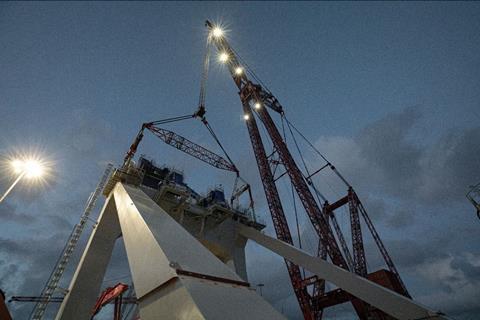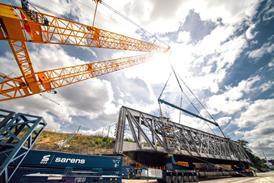Mammoet has used its PTC210-DS ring crane to lift a large A-frame for Van Oord’s offshore installation vessel, Svanen.

When the Van Oord-owned vessel Svanen received a major upgrade, a key element was fitting a bigger A-frame. This would enable it to install larger, next-generation monopile foundations for offshore wind turbines at sea.
Weighing 960 tonnes, measuring 26 m in width and 30 m in height, the new frame would increase the total height of Svanen to 125 m.
Mammoet’s PTC ring crane was suitable for the job, as it is one of the few cranes in the world capable of lifting the component to the 65 m height required to clear the vessel’s deck. This not only allowed for safer assembly of the A-frame but dramatically reduced the downtime of the offshore wind vessel. A project that could take a year was completed in a few months, said Mammoet.
Mammoet was approached to support two elements of the project. The first was the transportation and lifting of the three key components of the A-frame. The second stage was the main PTC hoist.
The frame components were fabricated by Holland Shipyards at two separate warehouses near Rotterdam, before being shipped by inland vessels to Mammoet’s quayside headquarters in Schiedam. Once in Schiedam, the A-frame was offloaded onto Mammoet SPMTs and moved to a laydown area. For this phase, a combination of gantry masts, crawler cranes, a 250-tonne harbour crane and floating sheerlegs were utilised.
The second stage saw the assembled A-Frame driven 66 m using 64 axle lines of SPMTs and parked on a temporary support, ready for the PTC to perform the hoist. The configuration of the PTC ring crane to perform the lift was 107 m of main boom, 67 m of luffing jib, and more than 4,000 tonnes of counterweight.
Mammoet said that it wasn’t possible to precisely know the fame’s final weight, nor its exact centre of gravity.
Julian Alkemade, project manager at Mammoet, explained: “We were able to estimate a certain weight before putting it on a vessel and shipping it to Schiedam for final assembly, but you always have the issue that if you combine those parts together, weld them together, bolt them together, you are unsure of what the exact weight will be. There is always deviation within a certain percentage.”
Because of this, the team weighed the A-frame once it was assembled. It also planned two separate rigging configurations, with the direction to be taken resting on the results of the weighing. “Between the hook of the crane and the A-frame itself there is a lot of steel, shackles and grommets, so we had two plans,” adds Alkemade.
“The weighing campaign was a very important, and integral, part of the process. It determined whether we used longer/shorter grommets, larger/smaller shackles, or changed the lifting eyes.”
Installation of the A-frame took just one week.
















